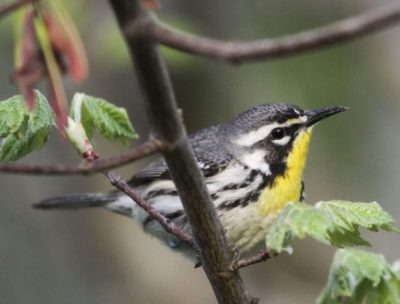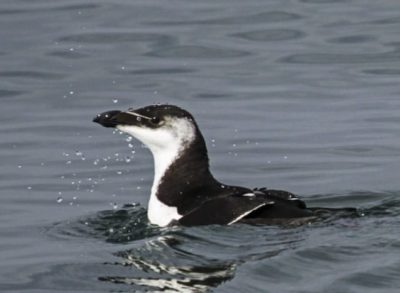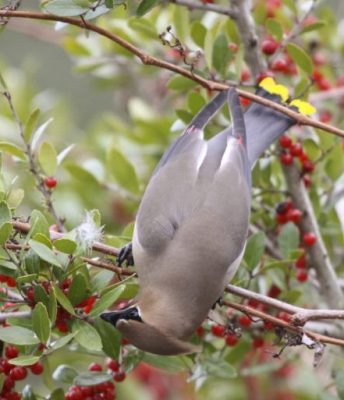
Reprinted from the Outer Banks Voice
March, at last. The days are growing longer, the temperatures are rising, shorts are back in style and spring is right around the corner. Sure signs of spring here on the Outer Banks are the return of the ospreys and laughing gulls this month.
Supporter Spotlight
For birdwatchers, March is a transitional month. The winter waterfowl are clearing out for the summer and traveling north and west to breed. Neotropical migrants are just starting to show up: beautiful warblers, swallows and gnatcatchers. And, our resident birds are beginning the breeding process, singing and searching for mates.
After the hoard of ducks and swans all winter the Pea Island impoundments in March are eerily quiet.
You can find a few species in March, but you’re better off birding the ocean, where you can still see plenty of birds. In addition to sanderlings and willets, brown pelicans numbers will have increased and they will be gliding by in their formations.
Northern gannets and red-throated loons should still be plentiful, and large flocks of red-breasted mergansers may be found. Look also for common loons and horned grebes. Scoters, or sea ducks, may be seen as they migrate north in their long strings. Near the inlets, look for the return of royal terns and black skimmers.
Razorbills have been plentiful again this winter, and a few should still be around in early March. These are really cool birds that resemble penguins. They are black and white and have a bill like a razor. These birds dive deep for their fish and shrimp prey.
Supporter Spotlight
Dainty Bonaparte’s gulls are numerous in March and this is a great time to search their flocks for they are little gull, a visitor from Eurasia. Look for a gull even smaller than the Bonaparte’s that has rounded wings that are dark on the underside.
A spotting scope is a big help in spotting this tiny gull, although persistence and luck are more important!
The first neo-tropical warblers to arrive in spring are yellow-throated warblers, black-throated green warblers and common yellowthroats. Their beautiful songs can be heard on the Alligator River National Wildlife Refuge and anywhere else the habitat is suitable.
Other songbirds to look for in March are blue-gray gnatcatchers, white-eyed vireos, barn swallows, tree swallows and purple martins, especially toward the end of the month.

In the salt and brackish marshes, you can easily hear red-winged blackbirds and marsh wrens singing. The blackbirds are easier to see than the skulking wrens, though. You may also detect the grunting sounds of clapper and Virginia rails from deep in the grass.
Everyone’s getting in the mood for romance.
In the backyard, cardinals, blue jays, chickadees, bluebirds and the rest of the gang are pairing up and looking for good nesting sites, too.
I hope you have your bird houses cleaned out from last year. Keep those bird feeders filled with seed, especially black oil.
The demand for suet should increase as the temperatures rise.
Around the end of the month, you can put out your hummingbird feeders – the ruby-throats arrive in April. I recommend an ant moat above the feeder to keep out the ants.
If you still have fruit on your holly and pyracantha bushes, look for hoards of cedar waxwings in March. They will also swarm a clean bird bath. These beautiful birds are always a crowd pleaser. In fact, let’s take an in-depth look at this beauty.
Cedar waxwings are arguably one of the most beautiful birds that we have. Theirs is not the flashy, bright beauty of a northern cardinal or a painted bunting, but a more subtle, elegant beauty.
They are a smooth pale brown and yellow with a black mask and sleek crest. Their tail is dipped in lemon yellow and their inner wing tips show red, waxy tips, hence the name – waxwing.
Cedar waxwings travel in flocks most of the year, only disbanding to nest. In our area, waxwings first show up in small numbers in fall and their flocks increase until in late winter and early spring “everybody” is seeing them.
They swarm trees and shrubs that are hanging with ripe berries, eating with an astonishing intensity. Sometimes they even get a little “tipsy” if the fruits have started to ferment.
Their favorite foods during this time of year are cedar (Juniper) cones, firethorn (Pyracantha) berries, privet (Ligustrum) drupes and various holly (Ilex) fruits. I’ve also seen waxwings devouring over-ripe crabapples. Cedar waxwings will also feed on insects and flower petals, especially in spring and summer.

When not feeding, waxwings can be seen perched on high limbs, usually in the sun. If you have good ears, you may hear a high-pitched trilling coming from the flock.
Cedar Waxwings have only begun to — sparingly — nest in our area in recent years. Their nests are most likely to be in pine trees and they are difficult to find.
Usually what gives them away is an adult bird carrying nesting material or food back and forth to a particular tree. I’ve found evidence of nesting cedar waxwings now in Dare, Camden and Currituck counties in recent years.
Cedar waxwings usually begin nesting about mid-May and it extends through the summer. The female usually lays from three to five eggs and they can raise two broods some years. Juvenile birds, once they have left the nest, can be identified by the duller plumage and the streaking on the breast and sides.
While birding this month, keep your eyes peeled for one of the most spectacular birds in the country, the swallow-tailed kite. A few are seen each March and April along the Outer Banks. These unmistakable, black and white raptors, with their long forked tails, have to be seen to be believed.
Swallow-tailed kites are the very essence of grace. They “kite” over the land, plucking insects, small snakes and lizards from treetops.
Although they nest well south of here, they have been recently discovered nesting in southernmost North Carolina, seemingly spreading northward. Let’s keep our fingers crossed.
Good birding!
This story is provided courtesy of the Outer Banks Voice, a digital newspaper covering the Outer Banks. Coastal Review Online is partnering with the Voice to provide readers with more environmental and lifestyle stories of interest about our coast.







